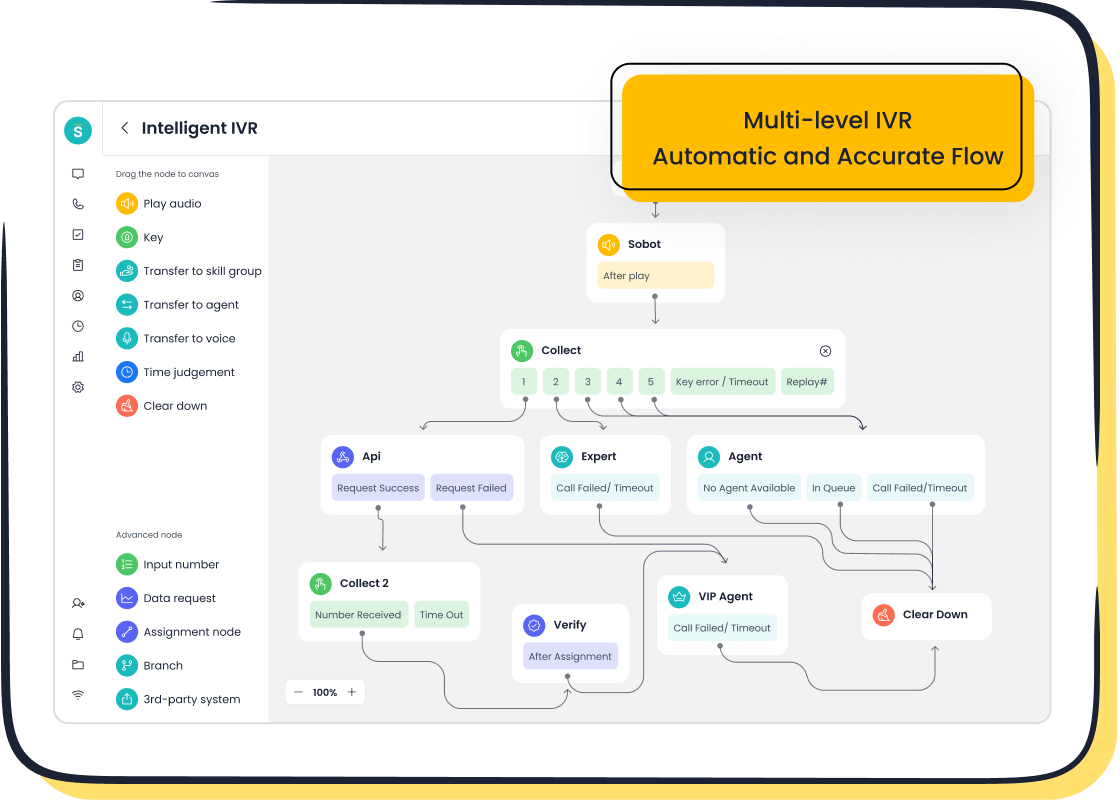Telemarketing vs Telesales vs Inside Sales Explained


Telemarketing, telesales, and inside sales play distinct roles in driving business growth. Sales telemarketing focuses on generating interest and leads, while telesales directly converts those leads into sales. Inside sales, on the other hand, emphasizes building relationships and closing deals remotely. Understanding these differences helps you choose the right strategy to meet your goals. For example, telemarketing calls have a success rate of 8.21%, making it a proven method for lead generation. Tools like Sobot's Voice/Call Center solution streamline these processes by offering features such as intelligent IVR and AI-powered coaching, boosting efficiency and customer satisfaction.
What Are Telemarketing, Telesales, and Inside Sales?
Understanding the distinctions between telemarketing, telesales, and inside sales is essential for businesses aiming to optimize their sales strategies. Each approach serves a unique purpose and employs specific methods to achieve its goals.
Telemarketing
Definition and Purpose
Telemarketing involves reaching out to potential customers over the phone to promote products, services, or ideas. Its primary goal is to generate interest and identify potential leads. Unlike telesales, which focuses on closing deals, telemarketing emphasizes creating awareness and building connections. Businesses often use telemarketing as a tool for market research, customer surveys, and lead generation.
Common Activities
Telemarketing activities include:
- Lead generation: Identifying and qualifying potential customers.
- Conducting surveys to gather customer feedback or market insights.
- Promoting events or webinars to attract attendees.

For example, companies like Opay have successfully used telemarketing to streamline customer outreach and improve engagement through tools like Sobot's Voice/Call Center solution. Features such as intelligent IVR and call tracking enhance efficiency in these activities.
Telesales
Definition and Purpose
Telesales focuses on converting leads into actual sales through direct phone interactions. It is a more targeted approach compared to telemarketing, with the primary objective of driving revenue. Telesales representatives often engage with warm leads or existing customers, making it a highly result-oriented process.
Common Activities
Telesales activities include:
- Selling products or services directly to customers.
- Upselling or cross-selling to existing clients.
- Following up on leads generated by telemarketing efforts.

For instance, telesales teams can leverage Sobot's AI-powered Voicebot to personalize conversations and improve conversion rates. This approach ensures that every interaction is tailored to the customer's needs, increasing the likelihood of closing a sale.
Inside Sales
Definition and Purpose
Inside sales involves selling products or services remotely, often using digital tools and platforms. Unlike telemarketing and telesales, inside sales prioritize building long-term relationships with clients, particularly in B2B settings. This method is ideal for high-value transactions and complex sales processes.
Common Activities
Inside sales activities include:
- Conducting remote sales meetings via video calls or digital platforms.
- Engaging prospects through email campaigns and CRM systems.
- Nurturing leads over time to build trust and loyalty.

Inside sales teams benefit from tools like Sobot's unified workspace, which integrates customer data and communication channels. This streamlined approach allows representatives to focus on meaningful interactions, ultimately driving better results.
Key Differences Between Telemarketing, Telesales, and Inside Sales
Understanding the differences between telemarketing, telesales, and inside sales helps you choose the right approach for your business. Each method has unique goals, tools, and audiences, making them suitable for specific scenarios.
Goals and Objectives
Telemarketing: Focus on awareness and lead generation
Telemarketing aims to create awareness about your products or services. It focuses on generating interest and identifying potential leads. Activities like surveys, appointment-setting, and market research fall under telemarketing. For example, a company might use telemarketing to gauge customer interest in a new product before launching it.
Telesales: Focus on closing deals and direct sales
Telesales revolves around achieving sales targets by converting leads into customers. The primary goal is closing deals during phone interactions. Telesales representatives often work with warm leads or existing customers, ensuring a higher success rate. For instance, a telesales team might follow up on leads generated by telemarketing to sell a subscription service.
Inside Sales: Focus on building relationships and long-term sales
Inside sales emphasizes building relationships with clients, especially in B2B settings. The objective is to nurture leads and close high-value deals over time. This approach works well for businesses offering complex solutions or services. For example, an inside sales team might use video calls to demonstrate a software product to a potential client.
Methods and Tools
Telemarketing: Primarily phone-based
Telemarketing relies heavily on phone calls to reach a broad audience. Tools like Sobot's Voice/Call Center solution enhance telemarketing efforts with features such as intelligent IVR and call tracking. These tools streamline workflows and improve efficiency.
Telesales: Phone and CRM tools
Telesales combines phone interactions with CRM tools to manage customer data and track progress. Sobot's AI-powered Voicebot can assist telesales teams by personalizing conversations, making it easier to close deals. This integration ensures that every call aligns with the customer's needs.
Inside Sales: Digital platforms, video calls, and CRM systems
Inside sales uses digital tools like video conferencing platforms and CRM systems to engage prospects. Sobot's unified workspace simplifies this process by integrating communication channels and customer data. This setup allows inside sales teams to focus on meaningful interactions and long-term success.
Target Audience
Telemarketing: Broad audience
Telemarketing targets a wide audience to generate leads and gather insights. It works well for businesses looking to expand their reach or conduct market research. For example, a retail brand might use telemarketing to promote an upcoming sale to a large customer base.
Telesales: Warm leads or existing customers
Telesales focuses on engaging warm leads or existing customers. This targeted approach increases the likelihood of closing deals. A financial services company, for instance, might use telesales to upsell premium accounts to current clients.
Inside Sales: B2B or high-value clients
Inside sales caters to B2B clients or high-value customers who require a personalized approach. This method is ideal for industries like technology or enterprise services. For example, an inside sales team might work with a manufacturing company to finalize a long-term partnership.
Advantages and Disadvantages of Each Approach
Telemarketing
Advantages
Telemarketing offers a cost-effective way to reach a large audience quickly. It allows you to generate leads, conduct surveys, and promote events without the need for face-to-face interactions. This scalability makes it ideal for businesses looking to expand their reach. For example, a retail company can use telemarketing to inform thousands of customers about an upcoming sale in just a few hours. Tools like Sobot's Voice/Call Center solution enhance telemarketing efforts by automating call routing and providing real-time analytics, ensuring efficient operations.
Disadvantages
Despite its benefits, telemarketing often faces challenges like lower conversion rates. Many recipients may view telemarketing calls as intrusive, which can lead to a negative perception of your brand. Additionally, telemarketing relies heavily on high call volumes, which may not always translate into meaningful customer engagement. To mitigate these issues, using features like Sobot's AI-powered Voicebot can help personalize interactions and improve customer satisfaction.
Telesales
Advantages
Telesales focuses on direct revenue generation, making it a highly result-oriented approach. It allows you to engage with warm leads or existing customers, increasing the likelihood of closing deals. This method also provides measurable ROI, as every call directly contributes to sales targets. For instance, a financial services company can use telesales to upsell premium accounts to current clients. Sobot's CRM integration further enhances telesales by streamlining customer data management and enabling personalized conversations.
Disadvantages
Telesales requires skilled salespeople who can handle objections and close deals effectively. This need for expertise often results in higher operational costs. Additionally, telesales teams must invest time in follow-ups, which can slow down the sales process. However, leveraging tools like Sobot's intelligent IVR can optimize workflows, allowing your team to focus on high-priority leads.
Inside Sales
Advantages
Inside sales excels in building long-term relationships with customers, especially in B2B settings. This approach enables you to engage high-value clients through personalized interactions, such as video calls or tailored email campaigns. Inside sales also supports complex sales processes, making it ideal for industries like technology or enterprise services. Sobot's unified workspace simplifies this process by integrating communication channels and customer data, helping your team deliver exceptional service.
Disadvantages
Inside sales can be resource-intensive, requiring significant time and effort to nurture leads. The longer sales cycles associated with this approach may delay revenue generation. Additionally, inside sales teams often rely on advanced tools and platforms, which can increase costs. However, solutions like Sobot's Voice/Call Center offer features like global number availability and AI-powered insights, reducing operational inefficiencies and enhancing productivity.
When to Use Telemarketing, Telesales, or Inside Sales
Choosing the right approach—telemarketing, telesales, or inside sales—depends on your business goals, target audience, and the nature of your offerings. Each method serves a specific purpose, making it essential to align your strategy with your objectives.
Telemarketing
Best for lead generation and market research
Telemarketing works best when your goal is to generate leads or gather insights about your market. It allows you to reach a broad audience efficiently, making it ideal for businesses aiming to expand their customer base or test new ideas. For example, a company launching a new product can use telemarketing to gauge interest and collect feedback from potential customers.
This approach also supports activities like surveys and event promotions. Tools like Sobot's Voice/Call Center enhance telemarketing efforts by automating call routing and providing real-time analytics. These features help you streamline operations and focus on building meaningful connections with your audience.
Telesales
Best for selling products or services directly
Telesales excels in converting leads into sales. It focuses on engaging warm leads or existing customers, making it a highly targeted and result-driven approach. If your business aims to boost revenue quickly, telesales is the way to go. For instance, a subscription-based service can use telesales to upsell premium plans to current users.
Sobot's AI-powered Voicebot can personalize conversations, ensuring that each interaction aligns with the customer's needs. This tailored approach increases the likelihood of closing deals while maintaining a positive customer experience.
Inside Sales
Best for B2B sales or high-value transactions
Inside sales is the preferred choice for businesses dealing with complex sales processes or high-value transactions. It emphasizes relationship-building and long-term engagement, particularly in B2B settings. For example, a software company can use inside sales to demonstrate its product's value through video calls and detailed presentations.
This method relies on digital tools like CRM systems and video conferencing platforms. Sobot's unified workspace integrates these tools, allowing your team to manage customer interactions seamlessly. This setup ensures that you can focus on nurturing leads and closing deals effectively.
How Sobot Can Help

Overview of Sobot's Voice/Call Center solutions for telemarketing and telesales
Sobot's Voice/Call Center solutions empower businesses to execute telemarketing and telesales strategies with precision and efficiency. These tools simplify the process of reaching a broad audience while maintaining effective communication. For telemarketing, features like intelligent IVR and bulk outbound tasks allow you to automate call routing and prioritize leads. This ensures that your team can focus on generating interest and identifying potential customers without wasting time on manual processes.
In telesales, Sobot's AI-powered Voicebot enhances customer engagement by personalizing conversations. This technology adapts to customer responses, making interactions more meaningful and increasing the likelihood of closing deals. Additionally, real-time call tracking and analytics provide actionable insights, helping you refine your approach and achieve better results. By integrating these features, Sobot enables you to streamline operations and maximize the impact of your telemarketing and telesales efforts.
How Sobot's CRM tools enhance inside sales strategies
Inside sales teams thrive on building relationships and understanding customer needs. Sobot's CRM tools offer a unified workspace that integrates customer data, communication channels, and task management into one platform. This setup allows you to maintain consistent engagement with prospects and clients, ensuring every interaction is informed and purposeful.
For example, Sobot's CRM system supports video calls, email campaigns, and detailed customer profiles, making it easier to nurture high-value leads. The platform also provides AI-driven insights, helping you identify opportunities and tailor your approach to meet specific client needs. With these tools, your inside sales team can focus on fostering trust and driving long-term success, all while reducing inefficiencies in the sales process.
Comparison Table: Telemarketing vs Telesales vs Inside Sales
Summary of Key Differences
Goals, methods, tools, and target audience
Understanding the distinctions between telemarketing, telesales, and inside sales can help you align your strategy with your business objectives. Each approach serves a unique purpose and employs specific tools to achieve its goals.
-
Goals:
- Telemarketing focuses on generating interest and identifying potential leads.
- Telesales aims to convert those leads into direct sales.
- Inside sales prioritizes building long-term relationships and closing high-value deals.
-
Methods:
- Telemarketing relies on high call volumes to reach a broad audience.
- Telesales uses targeted phone interactions to engage warm leads or existing customers.
- Inside sales leverages digital platforms like video calls and CRM systems for personalized engagement.
-
Tools:
- Telemarketing benefits from tools like Sobot's Voice/Call Center, which offers intelligent IVR and bulk outbound tasks to streamline outreach.
- Telesales teams enhance their efforts with AI-powered Voicebots and CRM integrations for tailored conversations.
- Inside sales thrives on unified workspaces, such as those provided by Sobot, which integrate customer data and communication channels.
-
Target Audience:
- Telemarketing targets a broad audience, making it ideal for market research or awareness campaigns.
- Telesales focuses on warm leads or existing customers, ensuring higher conversion rates.
- Inside sales caters to B2B clients or high-value customers who require a more personalized approach.
Summary of Benefits and Drawbacks
Quick reference for decision-making
Each approach offers distinct advantages and challenges. This quick comparison can guide you in selecting the right method for your business needs.
-
Telemarketing:
- Benefits: Cost-effective for reaching large audiences. Ideal for lead generation and surveys.
- Drawbacks: Lower conversion rates. May face resistance due to intrusive perceptions.
-
Telesales:
- Benefits: Directly drives revenue. Highly measurable ROI.
- Drawbacks: Requires skilled agents. Higher operational costs.
-
Inside Sales:
- Benefits: Builds strong client relationships. Effective for high-value transactions.
- Drawbacks: Resource-intensive. Longer sales cycles.
For example, businesses using Sobot's Voice/Call Center have reported a 48% increase in reception efficiency. Features like real-time analytics and AI-powered coaching ensure that each approach delivers maximum impact. Whether you aim to generate leads, close deals, or nurture relationships, Sobot's solutions provide the tools you need to excel in communication and sales.
Understanding the differences between telemarketing, telesales, and inside sales is essential for crafting an effective strategy. Telemarketing focuses on generating leads and gathering insights, while telesales drives direct sales by converting those leads. Inside sales builds a deeper relationship with clients, making it ideal for high-value transactions. Each approach serves a unique purpose, and selecting the right one depends on your business goals and resources.
Sobot's Voice/Call Center solutions simplify these processes. Whether you aim to generate leads, close deals, or nurture long-term relationships, Sobot provides tools like intelligent IVR and AI-powered Voicebots to enhance personal interaction and streamline operations. By aligning your strategy with the right tools, you can achieve measurable success and build lasting customer connections.
FAQ
What is the main difference between telemarketing, telesales, and inside sales?
Telemarketing focuses on generating interest and identifying potential leads. Telesales takes those leads and converts them into direct sales. Inside sales emphasizes building long-term relationships and closing high-value deals, often in B2B settings. Each approach serves a unique purpose, so understanding these distinctions helps you align your sales strategy with your business goals.
How do I decide which approach is best for my business?
Your choice depends on your target audience and sales goals. If you aim to generate leads or conduct market research, telemarketing is ideal. For direct revenue generation, telesales works best. Inside sales suits businesses handling complex sales processes or high-value transactions. Tools like Sobot's Voice/Call Center can support all three approaches by streamlining communication and improving effectiveness.
Can telemarketing and telesales be used together?
Yes, combining telemarketing and telesales creates a seamless sales funnel. Telemarketing generates leads and builds awareness, while telesales converts those leads into customers. This dynamic customer interaction ensures a smoother transition from interest to purchase. For example, Sobot's AI-powered Voicebot can assist in both stages, enhancing efficiency and personalization.
What tools can improve the effectiveness of these sales strategies?
Using advanced tools like Sobot's Voice/Call Center enhances your sales strategy. Features such as intelligent IVR, call tracking, and AI-powered Voicebots streamline operations and improve customer engagement. These tools help you manage high call volumes, personalize interactions, and track performance in real time, ensuring you meet your sales goals efficiently.
How does inside sales differ from field sales?
Inside sales relies on remote communication methods like video calls and CRM systems, while field sales involves face-to-face meetings. Inside sales is more cost-effective and scalable, making it ideal for businesses targeting B2B clients or managing high-value transactions. Sobot's unified workspace supports inside sales by integrating customer data and communication channels into one platform.
Are telemarketing calls considered cold calls?
Most telemarketing calls are cold calls because they target a broad audience to generate leads. However, not all cold calls fall under telemarketing. Inside sales teams may also use cold calling techniques, but their approach is more research-driven and personalized. Tools like Sobot's Voice/Call Center can help refine cold calling strategies by providing actionable insights.
What industries benefit most from inside sales?
Industries like technology, enterprise services, and manufacturing often benefit from inside sales. These sectors deal with complex products or services that require detailed explanations and relationship-building. For example, a software company can use inside sales to demonstrate its product's value through video calls and tailored presentations, supported by Sobot's CRM tools.
How can Sobot's solutions help improve my sales strategy?
Sobot's Voice/Call Center offers features like intelligent IVR, AI-powered Voicebots, and real-time analytics to enhance your sales strategy. These tools streamline telemarketing, telesales, and inside sales processes, allowing you to focus on achieving your sales goals. By integrating customer data and automating workflows, Sobot ensures you deliver dynamic customer interactions that drive results.
What are the advantages of using AI in telesales?
AI enhances telesales by personalizing conversations and adapting to customer responses. Sobot's AI-powered Voicebot, for instance, ensures every interaction aligns with the customer's needs, increasing the likelihood of closing deals. AI also reduces manual tasks, allowing your team to focus on high-priority leads and improving overall effectiveness.
How does Sobot ensure data security in its solutions?
Sobot prioritizes data security with encrypted data transfer and a 99.99% system uptime. These measures protect sensitive customer information and ensure reliable operations. Whether you're managing telemarketing, telesales, or inside sales, Sobot's solutions provide a secure and stable platform for all your communication needs.
See Also
Comprehensive Overview of Omnichannel Call Center Tools
Best Contact Center Solutions Analyzed for 2024
Understanding the Efficiency of Call Center Automation
